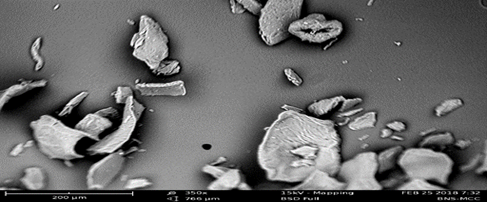Extraction and Characterization of Pharmaceutical Grade Microcrystalline Cellulose From Bambara Nut (Voandzeia Subterranean (L) Thousars) Husk
Keywords:
Extraction, Characterization, Bambara nut husk, Microcrystalline celluloseAbstract
Microcrystalline cellulose is a vital ingredient in the food, pharmaceutical, and cosmetics industries. In this study, Bambara nutshell microcrystalline cellulose (BNS-MCC) was prepared by acid hydrolysis modification of Bambara nutshell alpha-cellulose pulp. The sample was subjected to sodium hydroxide pulping (2.0% and 17.5% NaOH respectively) and a multistage pulping treatment using 3.5% nitric acid. The analysis results showed that the pulping method was effective for substantial removal of lignin with a 14.416% yield of alpha-cellulose pulp. The organoleptic and physicochemical properties of BNS-MCC were examined. The prepared BNS-MCC powder was examined using a Scanning Electron Microscope (SEM), Fourier Transform Infrared spectroscopy (FTIR), and X-ray Diffractometer (XRD). The sample’s powder flow properties (true density, Hausner index, Carr’s index, angle of repose,
powder porosity, loss on drying, and moisture sorption capacity) were (1.216g/mL, 1.34, 25.75%, 39.80o, 64.7%, and 46.81%). The results of the analysis of the BNS-MCC compared well with commercial grades and conformed to US Pharmacopeia (USP) and British Pharmacopeia specifications. This result shows that Bambara nutshells have potential application for pharmaceutical grade cellulose production used in direct compression tableting.

Published
How to Cite
Issue
Section
Copyright (c) 2022 E. Agboeze, N. P. Ani, E. O. Omeje

This work is licensed under a Creative Commons Attribution 4.0 International License.
How to Cite
Similar Articles
- Matthew Olaleke Aremu, Stephen Olaide Aremu, Ibrahim Aliyu, David Bala Passali, Munir Hussaini, Benjamin Zobada Musa, Rasaq Bolakale Salau, Amino acids profile and health attributes of Bambara groundnut (Vigna subteranea L.) and sesame (Sesamum indicum L.): a comparative study , African Scientific Reports: Volume 4, Issue 1, April 2025
- M. A. Aliu, A. M. Junaid, A. Ibraheem, A. Ishaq, A. Lawal, K. E. Ayeni, A. R. Lawal, L. B. Abdulrauf, Dispersive liquid-liquid microextraction/HPLC techniques for determination of oxytetracycline and doxycycline residues in beef samples: method developments and statistical analysis , African Scientific Reports: Volume 2, Issue 1, April 2023
- R. Hamood, Samia Jamal, Zina A. Al Shadid, Mechanical Characterization of Armchair and Zigzag Single-walled Carbon Nanotube , African Scientific Reports: Volume 1, Issue 1, April 2022
- Damilola T. Ogundele, Yusuf A. Iyanda, Ifedayo J. Akinruli, Christiana O. Oke, Olusanya E. Oludele, Aliru O. Mustapha, Production of Clay-Based Water Filter Using Biomass of Bacillus Subtillis, Sawdust, Activated Charcoal, Periwinkle and Snail Shell as Additives , African Scientific Reports: Volume 2, Issue 2, August 2023
- V. Abanihi, K. K. Adama, I. B. Onyeachu, Electrochemical and Microstructural Characterization of Cr-Coated NdFeB in Neutral Wet Environment , African Scientific Reports: Volume 2, Issue 2, August 2023
- A. M. Magomya, U. V. Elisha, Removal of Azo Dye (Acid Red 18) from Aqueous Solution using a Bioadsorbent from Carica Papaya Peels , African Scientific Reports: Volume 2, Issue 2, August 2023
- A. A. Ibiyemi, B. M. Akinroye, O. P. Oladipo, I. E. Olaoye, M. T. Olatunji, T. I. Ogunniran, A. T. Oladimeji, A. O. Ogungbe, A. S. Olatunde, G. O. Ogunyemi, S. K. Aminu, A. F. Ojo, A. Adewole, J. I. Lawal, A. C. Adeniran, Synthesis and characterization of ZnO crystalline powder: effect on Alkaline pH , African Scientific Reports: Volume 4, Issue 2, August 2025
- E. K. Ukpoko, I. S. Eneji, Q. M. Amua, R. A. Wuana, Analysis of some heavy metals in foodstuffs contaminated with pesticides using a developed spot-test method , African Scientific Reports: Volume 4, Issue 1, April 2025
You may also start an advanced similarity search for this article.
Most read articles by the same author(s)
- E. U. Chukwuegbo, E. Agboeze, C. C. Ogbuanu, S. Amujiogu, Effect of Phthalonitrile and Alum on Flame Retardation Properties of 100% Cotton Fabric , African Scientific Reports: Volume 1, Issue 2, August 2022




